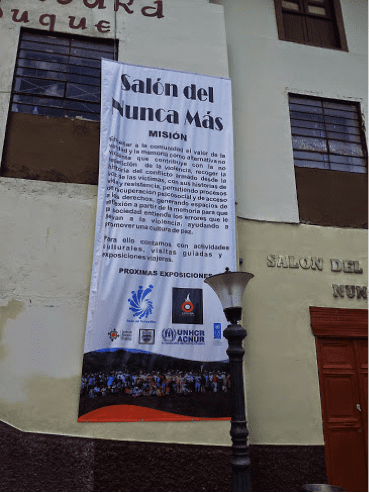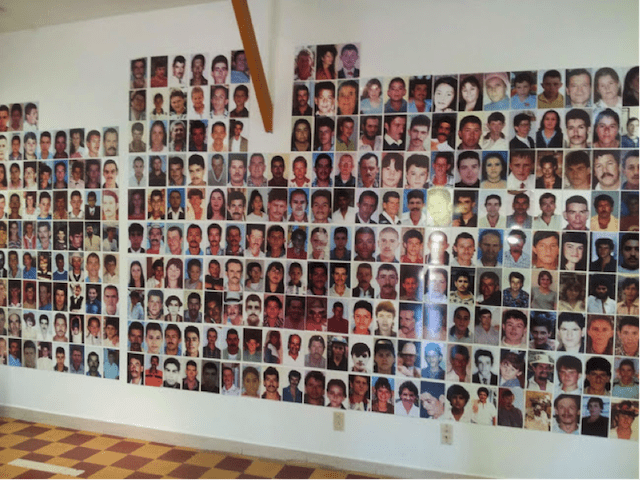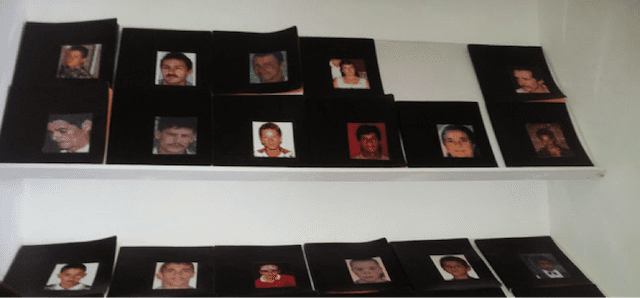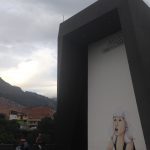By Jimena Perry
The Hall of Never Again (El Salón del Nunca Más) is located in Granada, in the highlands of Antioquia, Colombia. Granada is small place which lost 70% of its population between 1998 and 2000, going from 18,000 inhabitants to 5500 due to violence. The region saw near constant fighting among guerilla, paramilitary groups and the National Army between 1988 and the early 2000s.
When these violent episodes ended and the survivors felt it was safe to go back to their town and surrounding lands, they decided to get together to repair the urban area and remember those who died. With this in mind, they created the United Victims Association of the Municipality of Granada (Asociación de víctimas unidas del municipio de Granada), or Asovida, in 2005. The mayoralty gave them a space adjacent to the cultural center and Asovida used it to found The Hall of Never Again in 2009.
The Hall functions as a museum because it has displays and record books, and the coordinators attend workshops related to museum work, but they do not want to be considered a museum. Instead The Hall of Never Again, for them, is a memory place, a space for reflection and life.
The main goal of the Hall of Never Again is to make the public aware of the violence this community experienced. The main display consists of a wall covered with 180 photographs of some of the 2000 or more people of Granada who died since the 1980s. In this Hall, the survivors remember crimes such as 128 disappearances, 83 victims of landmines, and the displacement of nearly three-quarters of the population.
The intention of the picture display is to strike the visitor, to make him or her feel that these were persons just like them; people whose life affected a community and who therefore deserve remembrance. On another wall, there are children´s paintings, products of the workshops the project encouraged. To the left of the picture display there are images of 15 mass graves found in Granada. In another room, the visitor finds a large photograph of a march that took place in December 9, 2000, three days after one of the guerilla groups, the Revolutionary Armed Forces of Colombia (Fuerzas Armadas Revolucionarias de Colombia or FARC), disputing the territory with the National Liberation Army (Ejército de Liberación Nacional or ELN), destroyed the town. And still today, when someone is murdered, his or her picture becomes part of the wall.
One way the creators of this Hall have found to help the survivors cope with the brutal attacks they experienced is the use of bitácoras. These are notebooks where relatives and friends of the victims can express their sadness over their losses. The bitácoras are designed to make the grieving process easier. There are now approximately fifty bitácoras, in which one can find mothers talking to their children, husbands to their wives, brothers to sisters, children to their parents, wives to their spouses, and other family members remembering their departed loved ones.
These notebooks become both objects to be exhibited and historical sources for studying the violence endured by a particular person or family and how they survived. The bitácoras relate the history and character of the dead person, and why he or she was important. They also help the public and visitors of the Hall to learn about local history and to link the surivors to community reconstruction processes.
The Hall of Never Again is the response of a community commemorating its own history in the absence of State presence. Its funding does not come from the Colombian government and due to its scarce resources it only opens during the weekends. However, the Hall has received international agencies´ economic help and has won national peace prizes. The emergence of this Hall and the fact that their funding is not from the Colombian State demonstrates the unwillingness of the government to take care of all the victims of the armed conflict. It also shows a kind of indifference towards small towns and municipalities that do not represent a big contribution to the national economy. But as Gloria Quintero, one of the local leaders who made the Hall possible, said, the Hall represents “…the value of remembering. Our loved ones die when we forget them. We want children to learn that forgetting is not the way to mourn.”
All photographs taken in August 2014 by Jimena Perry.
This essay is based on interviews by the author and draws on the following printed sources:
“Sepultadas 21 personas de la masacre en Granada, Antioquia.” (Medellín: Caracol, 2000). Accesed April 9, 2014, http://www.caracol.com.co/noticias/judiciales/sepultadas-21-personas-de-la-masacre-en-granada-antioquia/20001105/nota/75878.aspx.
Alonso López, N. (2010) “Granada, Antioquia, el pueblo que dijo ´Nunca más´ a la violencia. El Tiempo. Bogotá






